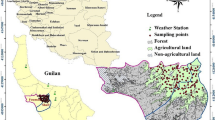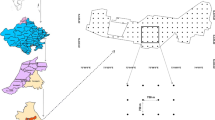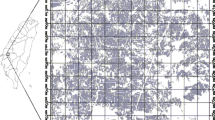Abstract
Precision agriculture has been increasingly practised in recent years. Under precision management, farmland is divided into several management zones to implement different strategies and improve irrigation water productivity and revenues. In this research, six soil properties (silt, sand, soil moisture content, available nitrogen, electrical conductivity and elevation) were selected, and fuzzy c-means clustering was used to delineate management zones. The field was divided into three zones. The differences in the mean of the soil properties among the zones were large and within a zone were small. The coefficient of variation of the properties and yield were also smaller than that before classification. The optimization was carried out by using a genetic algorithm based on the Jensen model. Three objective functions were set as maximum yield, maximum irrigation water productivity (IWP) and maximum revenue, and the weights were kept equal to 1/3. The WHCNS (soil water heat carbon nitrogen simulator) model was used to simulate the maize yield under optimized irrigation schedule for the three management zones and to calculate IWP and revenue. Compared with uniform management, IWP and revenue were increased by 0.6 kg m−3 and $61 ha−1, respectively. The optimized irrigation schedule can be used as a reference for the actual irrigation management. It can increase the IWP and revenue under the premise of achieving the target yield. The results show that the method can guide precision agricultural production and management in large-scale farmland.








Similar content being viewed by others
References
Abedinpour, M., Sarangi, A., Rajput, T. B. S., Man, S., Pathak, H., & Ahmad, T. (2012). Performance evaluation of AquaCrop model for maize crop in a semi-arid environment. Agricultural Water Management,110, 55–66.
Albornoz, E. M., Kemerer, A. C., Galarza, R., Mastaglia, N., Melchiori, R., & Martinez, C. E. (2017). Development and evaluation of an automatic software for management zone delineation. Precision Agriculture,2, 1–14.
Anwar, A. A., & Haq, Z. U. (2013). Genetic algorithms for the sequential irrigation scheduling problem. Irrigation Science,31, 815–829.
Basso, B., Cammarano, D., Chen, D., Cafiero, G., & Amato, M. (2009). Landscape position and precipitation effects on spatial variability of wheat yield and grain protein in Southern Italy. Journal of Agronomy and Crop Science,195, 301–312.
Bezdeck, J. C., Ehrlich, R., & Full, W. (1984). FCM: Fuzzy C-means algorithm. Computers and Geoscience,10, 191–203.
Blake, G. R. (1965). Bulk density. In C. A. Black (Ed.), Methods of soil analysis. Part 1. Physical and mineralogical properties (pp. 374–390). Madison, WI, USA: ASA and SSSA.
Botes, J. H. F., Bosch, D. J., & Oosthuizen, L. K. (1996). A simulation and optimization approach for evaluating irrigation information. Agricultural Systems,51, 165–183.
Bragato, G. (2004). Fuzzy continuous classification and spatial interpolation in conventional soil survey for soil mapping of the lower Piave plain. Geoderma,118, 1–16.
Çakir, R. (2004). Effect of water stress at different development stages on vegetative and reproductive growth of corn. Field Crops Research,89, 1–16.
Cambardella, C. A., Moorman, T. B., Parkin, T. B., Karlen, D. L., Novak, J. M., Konopka, A. E., et al. (1994). Field-scale variability of soil properties in central Iowa soils. Soil Science Society of America Journal,58, 1501–1511.
Corbeels, M., Chirat, G., Messad, S., & Thierfelder, C. (2016). Performance and sensitivity of the DSSAT crop growth model in simulating maize yield under conservation agriculture. European Journal of Agronomy,76, 41–53.
Corwin, D. L., & Lesch, S. M. (2003). Application of soil electrical conductivity to precision agriculture: Theory, principles, and guidelines. Agronomy Journal,95, 455–471.
Corwin, D. L., Loague, K., & Ellsworth, T. R. (1999). Assessing non-point source pollution in the vadose zone with advanced information technologies. In D. L. Corwin, K. Loague, & T. R. Ellsworth (Eds.), Assessment of non-point source pollution in the vadose zone. Geophysical monograph (Vol. 108, pp. 1–20). Washington, DC, USA: American Geophysical Union.
Dejonge, K. C., Kaleita, A. L., & Thorp, K. R. (2007). Simulating the effects of spatially variable irrigation on corn yields, costs, and revenue in Iowa. Agricultural Water Management,92, 99–109.
Deng, S. P., & Tabatabai, M. A. (1997). Effect of tillage and soil residue on enzyme activities in soils. III. Phosphotases and arylsulfatase. Biology and Fertility of Soils,24, 141–146.
Domínguez, A., Juan, J. A. D., Tarjuelo, J. M., Martínez, R. S., & Martínez-Romero, A. (2012a). Determination of optimal regulated deficit irrigation strategies for maize in a semi-arid environment. Agricultural Water Management,110, 67–77.
Domínguez, A., Martínez, R. S., Juan, J. A. D., Martínez-Romero, A., & Tarjuelo, J. M. (2012b). Simulation of maize crop behavior under deficit irrigation using MOPECO model in a semi-arid environment. Agricultural Water Management,107, 42–53.
Du, T., Kang, S., Sun, J., Zhang, X., & Zhang, J. (2010). An improved water use efficiency of cereals under temporal and spatial deficit irrigation in north China. Agricultural Water Management,97, 66–74.
Fridgen, J. J., Kitchen, N. R., Sudduth, K. A., Drummond, S. T., Wiebold, W. J., & Fraisse, C. W. (2004). Management zone analyst (MZA): Software for subfield management zone delineation. Agronomy Journal,96, 100–108.
Garten, C. T., Kang, S., Brice, D. J., Schadt, C. W., & Zhou, J. (2007). Variability in soil properties at different spatial scales (1 m-1 km) in a deciduous forest ecosystem. Soil Biology & Biochemistry,10, 2621–2627.
Georgiou, P. E., & Papamichail, D. M. (2008). Optimization model of an irrigation reservoir for water allocation and crop planning under various weather conditions. Irrigation Science,26, 487–504.
Guastaferro, F., Castrignanò, A., Benedetto, D. D., Sollitto, D., Troccoli, A., & Cafarell, B. (2010). A comparison of different algorithms for the delineation of management zones. Precision Agriculture,11, 600–620.
Guo, Q. S., Lei, Z. D., & Yang, S. X. (1996). Sensitive index of Jensen’s water production function model of wheat. Advances in Water Science,7, 20–25.
Hansen, S., Jensen, H. E., Nielsen, N. E., & Svendsen, H. (1991). Simulation of nitrogen dynamics and biomass production in winter wheat using the Danish simulation model daisy. Fertilizer Research,27, 245–259.
Isaaks, E. H., & Srivastava, R. M. (1989). An introduction to applied geostatistics (p. 561). New York, USA: Oxford University Press.
Jaynes, D. B., Kaspar, T. C., Colvin, T. S., & James, D. E. (2003). Cluster analysis of spatiotemporal corn yield patterns in an Iowa field. Agronomy Journal,95, 574–586.
Jensen, M. E. (1968). Water consumption by agricultural plants. In T. T. Kozlowski (Ed.), Water deficits and plant growth (Vol. 2, pp. 1–22). New York, USA: Academic Press.
Kamphake, L. J., Hannah, S. A., & Cohen, J. M. (1967). Automated analysis for nitrate by hydrazine reduction. Water Research,1, 205–216.
Kang, S., Shi, W., & Zhang, J. (2000). An improved water-use efficiency for maize grown under regulated deficit irrigation. Field Crops Research,67, 207–214.
Kang, S., Zhang, L., & Trout, T. J. (2017). Improving agricultural water productivity to ensure food security under changing environments. Agricultural Water Management,179, 1–4.
Keating, B. A., Carberry, P. S., Hammer, G. L., Probert, M. E., Robertson, M. J., Holzworth, D., et al. (2003). An overview of APSIM, a model designed for farming systems simulation. European Journal of Agronomy,18, 267–288.
Khorsandi, N., & Nourbakhsh, F. (2008). Prediction of potentially mineralizable N from amidohydrolase activities in a manure-applied, corn residue-amended soil. European Journal of Soil Biology,44, 341–346.
Kipkorir, E. C., & Raes, D. (2002). Transformation of yield response factor into Jensen’s sensitivity index. Irrigation and Drainage Systems,16, 47–52.
Ko, J., Piccinni, G., & Steglich, E. (2009). Using EPIC model to manage irrigated cotton and maize. Agricultural Water Management,96, 1323–1331.
Kuo, S. F., Merkley, G. P., & Liu, C. W. (2000). Decision support for irrigation project planning using a genetic algorithm. Agricultural Water Management,45, 243–266.
Kyaw, T., Ferguson, R. B., Adamchuk, V. I., Marx, D. B., Tarkalson, D. D., & McCallister, D. L. (2008). Delineating site-specific management zones for pH-induced iron chlorosis. Precision Agriculture,9, 71–84.
Li, D. F., & Shao, M. A. (2014). Soil organic carbon and influencing factors in different landscapes in an arid region of northwestern China. CATENA,116, 95–104.
Li, S., Kang, S., Zhang, L., Du, T., Tong, L., Ding, R., et al. (2015a). Ecosystem water use efficiency for a sparse vineyard in arid northwest China. Agricultural Water Management,148, 24–33.
Li, T., Hao, X. M., & Kang, S. Z. (2016). Spatial variability of grapevine bud burst percentage and its association with soil properties at field scale. PLoS ONE,11, e0165738.
Li, Y., Shi, Z., Li, F., & Li, H. Y. (2007). Delineation of site-specific management zones using fuzzy clustering analysis in a coastal saline land. Computers and Electronics in Agriculture,56, 174–186.
Li, Z., Hu, K., Li, B., He, M., & Zhang, J. (2015b). Evaluation of water and nitrogen use efficiencies in a double cropping system under different integrated management practices based on a model approach. Agricultural Water Management,159, 19–34.
Liang, H., Hu, K., Batchelor, W. D., Qi, Z., & Li, B. (2016a). An integrated soil-crop system model for water and nitrogen management in North China. Scientific Reports,6, 25755.
Liang, H., Hu, K., & Li, B. (2016b). Parameter optimization and sensitivity analysis of soil-crop system model using PEST. Transactions of the Chinese Society of Agricultural Engineering,32, 78–85.
Liang, H., Hu, K., Qin, W., Zuo, Q., & Zhang, Y. (2017). Modelling the effect of mulching on soil heat transfer, water movement and crop growth for ground cover rice production system. Field Crops Research,201, 97–107.
Liang, H., Qi, Z., Hu, K., Prasher, S. O., & Zhang, Y. (2016c). Can nitrate contaminated groundwater be remediated by optimizing flood irrigation rate with high nitrate water in a desert oasis using the WHCNS model? Journal of Environmental Management,181, 16–25.
Ma, L., Trout, T. J., Ahuja, L. R., Bausch, W. C., Saseendran, S. A., Malone, R. W., et al. (2012). Calibrating RZWQM2 model for maize responses to deficit irrigation. Agricultural Water Management,103, 140–149.
Machado, S., Edjr, B., Archer, T. L., Bordovsky, J., Rosenow, D. T., Bynum, E. D., et al. (2002). Spatial and temporal variability of sorghum grain yield: Influence of soil, water, pests, and diseases relationships. Precision Agriculture,3, 389–406.
Mamedov, A. I., Levy, G. J., Shainberg, I., & Letey, J. (2001). Wetting rate, sodicity, and soil texture effects on infiltration rate and runoff. Soil Research,39, 1293–1305.
Mansourifar, C., Sanavy, S. A. M. M., & Saberali, S. F. (2010). Maize yield response to deficit irrigation during low-sensitive growth stages and nitrogen rate under semi-arid climatic conditions. Agricultural Water Management,97, 12–22.
Marques da Silva, J. R. (2006). Analysis of the spatial and temporal variability of irrigated maize yield. Biosystems Engineering,94, 337–349.
Marques da Silva, J. R., & Silva, L. L. (2008). Evaluation of the relationship between maize yield spatial and temporal variability and different topographic attributes. Biosystems Engineering,101, 183–190.
Moharana, P. C., Jena, R. K., Pradhan, U. K., Nogiya, M., Tailor, B. L., Singh, R. S., et al. (2019). Geostatistical and fuzzy clustering approach for delineation of site-specific management zones and yield-limiting factors in irrigated hot arid environment of India. Precision Agriculture. https://doi.org/10.1007/s11119-019-09671-9.
Moral, F. J., Terrón, J. M., & Marques da Silva, J. R. (2010). Delineation of management zones using mobile measurements of soil apparent electrical conductivity and multivariate geostatistical techniques. Soil and Tillage Research,106, 335–343.
Nash, J. E., & Sutcliffe, J. V. (1970). River flow forecasting through conceptual models. Part I. A discussion of principles. Journal of Hydrology,10, 282–290.
Nguyen, D. C. H., Ascough, J. C., Maier, H. R., Dandy, C. G., & Andales, A. (2017). Optimization of irrigation scheduling using ant colony algorithms and an advanced cropping system model. Environmental Modelling and Software,97, 32–45.
O’Kelly, B. C. (2004). Accurate determination of moisture content of organic soils using the oven drying method. Drying Technology,22, 1532–2300.
Odeh, I. O. A., Chittleborough, D. J., & Mcbratney, A. B. (1992). Soil pattern recognition with fuzzy-c-means: Application to classification and soil-landform interrelationships. Soil Science Society of America Journal,56, 505–516.
Pandey, R. K., Maranville, J. W., & Admou, A. (2000). Deficit irrigation and nitrogen effects on maize in a Sahelian environment. I. Grain yield and yield components. Agricultural Water Management,46, 1–13.
Peralta, N. R., & Costa, J. L. (2013). Delineation of management zones with soil apparent electrical conductivity to improve nutrient management. Computers and Electronics in Agriculture,99, 218–226.
Peralta, N. R., Costa, J. L., Balzarini, M., & Angelini, H. (2013). Delineation of management zones with measurements of soil apparent electrical conductivity in the southeastern pampas. Canadian Journal of Soil Science,93, 205–218.
Qi, Z., Feng, H., Zhao, Y., Zhang, T., Zhang, Z., & Yang, A. (2018). Spatial distribution and simulation of soil moisture and salinity under mulched drip irrigation combined with tillage in an arid saline irrigation district, northwest China. Agricultural Water Management,201, 219–231.
Reca, J., & Martinez, J. (2006). Genetic algorithms for the design of looped irrigation water distribution networks. Water Resources Research,42, 110–119.
Rossi, R. E., Mulla, D. J., Journel, A. G., & Franz, E. H. (1992). Geostatistical tools for modeling and interpreting ecological spatial dependence. Ecological Monographs,62, 277–314.
Ryżak, M., & Bieganowski, A. (2011). Methodological aspects of determining soil particle-size distribution using the laser diffraction method. Journal of Plant Nutrition and Soil Science,174, 624–633.
Sadati, S. K., Speelman, S., Sabouhi, M., Gitizadeh, M., & Ghahraman, B. (2014). Optimal irrigation water allocation using a genetic algorithm under various weather conditions. Water,6, 3068–3084.
Shukla, M. K., Slater, B. K., Lai, R., & Cepuder, P. (2004). Spatial variability of soil properties and potential management classification of a chernozemic field in lower Austria. Soil Science,169, 852–860.
Šimůnek, J. (2008). Development and applications of the HYDRUS and STANMOD software packages, and related codes. Vadose Zone Journal,72, 587–600.
Šimůnek, J., Genuchten, M. T. V., & Šejna, M. (2016). Recent developments and applications of the HYDRUS computer software packages. Vadose Zone Journal,7, 587–600.
Slavich, P. G., & Petterson, G. H. (1993). Estimating the electrical conductivity of saturated paste extracts from 1:5 soil, water suspensions and texture. Australian Journal of Soil Research,31, 73–81.
Timlin, D. J., Pachepsky, Ya., Snyder, V. A., & Bryant, R. B. (1998). Spatial and temporal variability of corn grain yield on a hillslope. Soil Science Society of America Journal,62, 764–773.
Tsakiris, G. P. (1982). A method for applying crop sensitivity factors in irrigation scheduling. Agricultural Water Management,5, 335–343.
van Liew, M. W., & Garbrecht, J. (2003). Hydrologic simulation of the Little Washita river experimental watershed using SWAT. Journal of the American Water Resources Association,39, 413–426.
Wakindiki, I. I. C. (2002). Soil mineralogy and texture effects on crust micromorphology, infiltration, and erosion. Soil Science Society of America Journal,66, 897.
Wang, Y. R., Lei, Z. D., & Yang, S. X. (1997). Cumulative function of sensitive index for winter wheat. Journal of Hydraulic Engineering,5, 29–36.
Warrick, A. W., & Nielsen, D. R. (1980). Spatial variability of soil physical properties in the field. In D. Hillel (Ed.), Applications of soil physics (pp. 319–344). New York, USA: Academic Press.
Wen, Y., Shang, S., & Yang, J. (2017). Optimization of irrigation scheduling for spring wheat with mulching and limited irrigation water in an arid climate. Agricultural Water Management,192, 33–44.
Willmott, C. J. (1982). Some comments on the evaluation of model performance. Bulletin of the American Meteorological Society,63, 1309–1313.
Xue, X., Mai, W., Zhao, Z., Zhang, K., & Tian, C. (2017). Optimized nitrogen fertilizer application enhances absorption of soil nitrogen and yield of castor with drip irrigation under mulch film. Industrial Crops and Products,95, 156–162.
Yang, S., Liu, F., Song, X., Lu, Y., Li, D., Zhao, Y., et al. (2019). Mapping topsoil electrical conductivity by a mixed geographically weighted regression kriging: A case study in the Heihe River Basin, northwest China. Ecological Indicators,102, 252–264.
Zhang, B., Yuan, S. Q., Li, H., Cong, X. Q., & Zhao, B. J. (2006). Optimized irrigation yield model for winter wheat based on genetic algorithm. Transactions of the Chinese Society of Agricultural Engineering,22, 12–15.
Zhang, J., Cheng, Z., & Zhang, R. (2012). Regulated deficit drip irrigation influences on seed maize growth and yield under film. Procedia Engineering,28, 464–468.
Zhao, W. X., Li, J. S., Yang, R. M., & Li, Y. F. (2018). Determining placement criteria of moisture sensors through temporal stability analysis of soil water contents for a variable rate irrigation system. Precision Agriculture,19, 648–665.
Zhou, Q. (2016). Influence of water and nitrogen management and planting density on the growth of seed maize under drip irrigation with mulch in an arid region of Northwest China (Masters thesis, China Agricultural University, Beijing) (In Chinese with English abstract).
Acknowledgements
This work was partially supported by the National Natural Science Foundation of China (Grant Nos. 51725904, 51439006, 51621061), the Research Projects of Agricultural Public Welfare Industry in China (201503125) and the Discipline Innovative Engineering Plan (111 Program, B14002). We thank NMSU Agricultural Experimental Station and Mr. Frank Sholedice for improving the manuscript.
Author information
Authors and Affiliations
Corresponding author
Additional information
Publisher's Note
Springer Nature remains neutral with regard to jurisdictional claims in published maps and institutional affiliations.
Rights and permissions
About this article
Cite this article
Chen, S., Wang, S., Shukla, M.K. et al. Delineation of management zones and optimization of irrigation scheduling to improve irrigation water productivity and revenue in a farmland of Northwest China. Precision Agric 21, 655–677 (2020). https://doi.org/10.1007/s11119-019-09688-0
Published:
Issue Date:
DOI: https://doi.org/10.1007/s11119-019-09688-0




